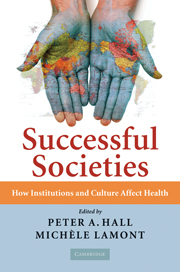Book contents
- Frontmatter
- Contents
- Contributors
- Preface
- Introduction
- 1 Population Health and the Dynamics of Collective Development
- 2 Social Interactions in Human Development: Pathways to Health and Capabilities
- 3 Health, Social Relations, and Public Policy
- 4 Population Health and Development: An Institutional-Cultural Approach to Capability Expansion
- 5 Responding to AIDS in Sub-Saharan Africa: Culture, Institutions, and Health
- 6 Responses to Racism, Health, and Social Inclusion as a Dimension of Successful Societies
- 7 Collective Imaginaries and Population Health: How Health Data Can Highlight Cultural History
- 8 Making Sense of Contagion: Citizenship Regimes and Public Health in Victorian England
- 9 The Multicultural Welfare State?
- 10 From State-Centrism to Neoliberalism: Macro-Historical Contexts of Population Health since World War II
- Bibliography
- Index
10 - From State-Centrism to Neoliberalism: Macro-Historical Contexts of Population Health since World War II
Published online by Cambridge University Press: 05 June 2012
- Frontmatter
- Contents
- Contributors
- Preface
- Introduction
- 1 Population Health and the Dynamics of Collective Development
- 2 Social Interactions in Human Development: Pathways to Health and Capabilities
- 3 Health, Social Relations, and Public Policy
- 4 Population Health and Development: An Institutional-Cultural Approach to Capability Expansion
- 5 Responding to AIDS in Sub-Saharan Africa: Culture, Institutions, and Health
- 6 Responses to Racism, Health, and Social Inclusion as a Dimension of Successful Societies
- 7 Collective Imaginaries and Population Health: How Health Data Can Highlight Cultural History
- 8 Making Sense of Contagion: Citizenship Regimes and Public Health in Victorian England
- 9 The Multicultural Welfare State?
- 10 From State-Centrism to Neoliberalism: Macro-Historical Contexts of Population Health since World War II
- Bibliography
- Index
Summary
The previous chapters of this book have shown that a society's institutional frameworks and cultural repertoires have a major impact on population health. But, as Hertzman and Saddiqi remarked in Chapter 1, such institutions and cultural repertoires also have a past and a future. The trajectory of a society's population health over time depends on the history of its institutions and cultural structures. It is, for example, well established that socioeconomic inequalities matter enormously to health outcomes – Link and Phelan call such inequalities a “fundamental cause” of disease. But even if we agree that inequality is a permanent feature of human societies, it is also true that class structures and social institutions change significantly over time. Historical changes can restructure the very parameters within which the determinants of population health have their effects. Jane Jenson's study of citizenship regimes in this volume illustrates this point starkly: sanitary policies known to be capable of greatly improving the health of British urban populations could not be applied systematically as long as that country's liberal citizenship regime remained in place. It was only when the citizenship regime was transformed by historical changes in the British political system in the years after 1870 that major improvements in urban population health were attainable.
The aim of this chapter is to trace out a set of changes in institutional and cultural frameworks that have conditioned health outcomes on a global scale since the end of World War II. It argues that during these years there has been a major transformation in the architecture of world capitalism – a shift from what I call a state-centric to a neoliberal paradigm of capitalist political economy – and that this shift has had important implications for population health.
- Type
- Chapter
- Information
- Successful SocietiesHow Institutions and Culture Affect Health, pp. 254 - 288Publisher: Cambridge University PressPrint publication year: 2009
- 6
- Cited by



